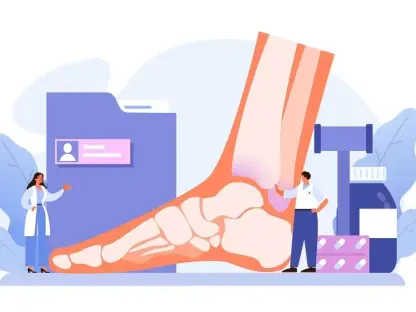Imagine a healthcare system where administrative tasks no longer bog down staff, where patient intake forms are processed in minutes rather than hours, and where clinical teams can focus on care instead of paperwork. This vision is becoming a reality with cutting-edge tools designed to streamline workflows in an industry burdened by inefficiency. At the forefront of this transformation is a powerful innovation from Notable, a conversational AI assistant integrated into a low-code platform. This review dives into the capabilities, real-world impact, and future potential of this technology, exploring how it addresses critical challenges in healthcare automation with accessibility and efficiency at its core.
Overview of the Technology and Its Healthcare Context
Healthcare organizations face mounting pressure to optimize operations amid resource constraints and rising patient demands. The introduction of AI-driven solutions has emerged as a lifeline, automating repetitive tasks and enhancing productivity across clinical and operational teams. Notable’s latest offering stands out by embedding a conversational assistant within a user-friendly, low-code environment, designed specifically to simplify the creation and management of automated workflows in medical settings.
This technology targets a broad audience, from technical developers to non-technical staff, by leveraging natural language interactions to reduce complexity. Its significance lies in addressing a key pain point: the administrative burden that consumes valuable time and resources. By integrating seamlessly into existing systems, it promises to revolutionize how healthcare providers approach workflow automation, making efficiency an achievable goal rather than a distant dream.
Key Features and Performance Analysis
Conversational Interface for Simplified Automation
One of the standout aspects of this technology is its conversational interface, which allows users to interact with the platform using everyday language. This feature breaks down traditional barriers associated with automation tools, enabling staff without coding expertise to design and refine workflows effortlessly. For instance, a nurse manager can input commands in plain English to automate patient scheduling, bypassing the need for specialized training.
The impact of this accessibility cannot be overstated. It empowers a wider range of healthcare professionals to participate in digital transformation, fostering collaboration across departments. By lowering the entry threshold, the tool ensures that automation is no longer the exclusive domain of IT specialists, thus accelerating adoption in diverse medical environments.
Real-Time Workflow Management and Smart Recommendations
Another critical strength lies in the ability to update workflows instantly and provide real-time insights into complex processes. Users can tweak automations on the fly, ensuring that changes are implemented without delay—a crucial advantage in fast-paced healthcare settings. This responsiveness minimizes downtime and keeps operations running smoothly even during unexpected shifts in demand or policy.
Equally impressive are the intelligent suggestions offered for routine tasks. These recommendations guide users through common automation scenarios, such as processing lab results or managing referrals, reducing errors and saving time. The combination of immediate updates and smart guidance enhances both the speed and precision of deploying solutions, making it a reliable asset for overburdened teams.
Platform Enhancements and User Experience Innovations
Recent updates to the underlying platform have further elevated its usability, with a redesigned navigation system that prioritizes ease of access. Features like a streamlined action bar and enhanced search capabilities allow users to locate tools and data with minimal effort. Such improvements cater to the practical needs of busy professionals who require intuitive interfaces to maintain focus on patient care.
Looking ahead, planned enhancements such as customizable user settings and dedicated administrative controls signal a commitment to continuous refinement. These additions aim to tailor the experience to individual preferences while supporting larger organizational goals. This focus on user-centric design ensures that the platform remains adaptable to evolving challenges in the healthcare landscape.
The iterative nature of these updates builds on a foundation of flexibility, allowing rapid adjustments to meet specific operational demands. Whether responding to new regulatory requirements or addressing staffing shortages, the platform equips users with the tools to innovate in-house, reducing dependency on external support and fostering self-reliance.
Real-World Impact in Medical Settings
The practical applications of this technology are already evident in various healthcare scenarios, from automating patient intake processes to handling prior authorizations with ease. Early adopters have reported substantial time savings, enabling staff to redirect their efforts toward direct patient engagement. For example, a prominent medical university health system noted significant reductions in manual workload, improving both staff morale and service delivery.
Integration with electronic health record systems stands as a key enabler of this success. By ensuring compatibility with existing infrastructure, the technology minimizes disruption during implementation, maintaining compliance with stringent data standards. This seamless connectivity is vital for organizations aiming to adopt automation without overhauling their current setups.
Beyond operational gains, the ripple effects extend to patient outcomes. With routine tasks handled efficiently, providers can offer more personalized attention, closing care gaps and enhancing satisfaction. These tangible benefits underscore the transformative potential of automation when tailored to the unique needs of the healthcare sector.
Adoption Challenges and Mitigation Strategies
Despite its promise, integrating this technology into traditional healthcare environments is not without hurdles. Staff training remains a concern, as even a low-code platform requires initial onboarding to ensure effective use. Resistance to change, often rooted in long-standing practices, can also slow adoption, necessitating cultural shifts within organizations.
Technical challenges, such as ensuring interoperability with diverse electronic health record systems, add another layer of complexity. Data security is paramount, given the sensitive nature of medical information, requiring robust safeguards to prevent breaches. These issues highlight the importance of thorough planning and support during deployment.
To address these obstacles, ongoing efforts include comprehensive user education through webinars and resources, alongside continuous platform improvements. By prioritizing customer feedback and offering tailored assistance, the developers aim to smooth the transition, ensuring that barriers do not overshadow the technology’s benefits. This proactive approach is essential for widespread acceptance.
Future Potential in Healthcare Automation
Looking toward the horizon, the evolution of this technology holds exciting possibilities for deeper personalization of workflows. Enhanced AI capabilities could enable predictive analytics, allowing providers to anticipate patient needs and allocate resources more effectively. Such advancements would shift automation from a reactive to a proactive tool in healthcare management.
The long-term vision includes further reducing administrative burdens, freeing up even more time for clinical priorities. As the platform matures, its influence could extend to shaping industry-wide trends, particularly the growing adoption of no-code solutions. This shift would empower more stakeholders to drive innovation collaboratively, redefining operational norms.
Additionally, potential integrations with emerging technologies could amplify its impact. By aligning with broader digital health ecosystems, the tool might support holistic care models, bridging gaps between providers and patients. This forward-thinking trajectory positions it as a cornerstone of future healthcare efficiency.
Final Thoughts and Next Steps
Reflecting on this evaluation, the conversational AI assistant and its low-code platform proved to be a game-changer in healthcare automation. Its accessibility, real-time functionality, and seamless integration with existing systems delivered measurable improvements in efficiency and patient care. The journey of early adopters showcased how it alleviated administrative pressures, paving the way for enhanced staff and patient experiences.
Moving forward, healthcare organizations should prioritize strategic onboarding to maximize the technology’s benefits, focusing on tailored training programs to overcome initial resistance. Exploring pilot programs within specific departments could serve as a low-risk entry point, building confidence in its capabilities. Additionally, staying engaged with developer updates will ensure alignment with evolving features and security standards.
As the healthcare sector continues to grapple with resource challenges, leveraging such innovations becomes not just an option but a necessity. Stakeholders are encouraged to assess their workflow pain points and consider how this tool could address them, taking a proactive step toward operational excellence. This technology, with its proven track record, offers a compelling solution in an era demanding smarter, more humane care delivery.









